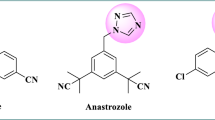Abstract
A series of novel 6,8-dibromo-2-aryl-2,3-dihydroquinolin-4(1H)-ones have been synthesized and evaluated in vitro (in MCF-7 breast cancer cell lines). Compounds 5a, 5d, 5e, and 5g exhibited potent GI50 and TGI values compared with reference standard and compounds 5b and 5c showed moderate activity. The docking studies (in silico) were conducted to recognize the hypothetical binding motif of the title compounds within the active site of aromatase enzyme employing GOLD docking software. The binding mode and SAR of the title compounds has been proposed based on the docking studies.




Similar content being viewed by others
References
GOLD v4.0.1 (2008) Cambridge Crystallographic Data Centre, Cambridge, UK
Baker LJ, Copp BR, Rickard CEF (2001) 2′-Amino-3′, 5′-dibromoacetophenone. Acta Cryst E57:538–539
Bandi P, Boone M, Brinton L, Buchert S (2010) Breast cancer facts & figures 2009–2010. American Cancer Society, Atlanta
Carlo DG, Mascolo N, Capasso F (1999) Flavonoids, old and new aspects of a class of natural therapeutic drugs. Life Sci 49:337–353
Chandrasekhar S, Vijeender K, Sridhar C (2007) l-Proline-catalyzed one-pot synthesis of 2-aryl-2, 3- dihydroquinolin-4(1H)-ones. Tetrahedron Lett 48:4935–4937
Donnelly JA, Farrell DF (1990a) Chalcone derivatives as precursors of 1, 2, 3, 4-tetrahydro-4-quinolones. Tetrahedron 46:885–894
Donnelly JA, Farrell DF (1990b) The chemistry of 2′-amino anologues of 2′-hydoxychalcone and its derivatives. J Org Chem 55:1757–1761
Ghosh D, Griswold J, Erman M, Pangborn W (2009) Structural basis for androgen specificity and oestrogen synthesis in human aromatase. Nature 457:219–224
ICMR (2008) Consolidated report of the population based cancer registries 2008. National Cancer Registry Programme, New Delhi
Jeong HJ, Shin YG, Kim IH, Pezzuto JM (1999) Inhibition of aromatase activity by flavonoids. Arch Pharm Res 22:309–312
Kao YC, Zhou C, Sherman M, Laughton CA, Chen S (1998) Molecular basis of the inhibition of human aromatase (estrogen synthetase) by flavone and isoflavone phytoestrogens: a site-directed mutagenesis study. Environ Health Perspect 106:85–92
Le-Bail JC, Laroche T, Marre-Fournier F, Habrioux G (1998) Aromatase and 17β-hydroxysteroid dehydrogenase inhibition by flavonoids. Cancer Lett 133:101–106
Leonard NJ, Boyd SN (1946) Cinnolines: synthesis of aminoacetophenones and aminopropiophenones. J Org Chem 11:405–418
Mooij WTM, Verdonk ML (2005) General and targeted statistical potentials for protein–ligand interactions. Proteins Struct Funct Bioinf 61:272–287
Murthy N, Rao AR, Sastry GN (2004) Aromatase inhibitors: a new paradigm in breast cancer treatment. Curr Med Chem Anticancer Agents 4:523–534
Murthy JN, Nagaraju M, Sastry GM, Rao AR, Sastry GN (2006) Active site acidic residues and structural analysis of medelled human aromatase: a potential drug target for breast cancer. J Comput Aided Mol Des 19:857–870
Needleman SJ, Tobias JS (2008) Aromatase inhibitors in early hormone receptor-positive breast cancer: what is the optimal initiation time for the maximum benefit? Drugs 68:1–15
Okada M, Yoden T, Kawaminami E, Shimada Y, Kudoh M, Isomura Y, Shikama H, Fujikura T (1996) Studies on aromatase inhibitors. I. Synthesis and biological evaluation of 4-amino-4H-1, 2, 4-triazole derivatives. Chem Pharm Bull 44:1871–1879
Pelissero C, Lenczowski MJ, Chinzi D, Cuisset DB, Sumpter JP, Fostier A (1996) Effects of flavonoids on aromatase activity, an in vitro study. J Steroid Biochem Mol Biol 57:215–223
Pouget C, Lauthier F, Simon AA (2001) Flavonoids: structural requirements for antiproliferative activity on breast cancer cells. Bioorg Med Chem Lett 11:3095–3097
Protein preparation (PPrep) Wizard (2009) Schrodinger LLC, New York
Rao AR, Murthy JN (2009) Novel tetrahydroquinolines as aromatase inhibitors. WO 2009087684A2
Skehn P, Storeng R, Scudiero A, Monks J, Mcmohan D, Vistica D, Jonathan TW, Bokesch H, Kenney S, Boyd MR (1990) New colorimetric cytotoxicity assay for anticancer drug screening. J Natl Cancer Inst 82:1107–1117
Tokes AL, Litkei G, Szilagyi LN (1992) Heterocycles by cyclization 2′-NHR chalcones, 2′-NHR chalcone dibromides and 2′-NHR azidochalcones. Synth Commun 22:2433–2445
Vanicha V, Kanyawim K (2006) Sulforhodamine B colorimetric assay for cytotoxicity screening. Nat Protoc 1:1112–1116
Wattanasin S, Murphy WS (1980) An improved procedure for the preparation of chalcones and related enones. Synth Commun 647:650
Acknowledgments
The authors thank the Chairman, University Institute of Pharmaceutical Sciences, Panjab University (PU), Chandigarh for providing the facilities and BLN thanks the University Grants Commission (UGC), New Delhi for granting a fellowship [Research Fellowship in Science for Meritorious Students, F.4-3/2006(BSR)/5-94/2007(BSR)] and AK, RA, and RS thank the UGC for providing JRF. We gratefully acknowledge Mrs. Lauren Thomas, CCDC, Cambridge, UK for providing the GOLD software. We thank Dr R. S. Varma (M/s Senative Therapeutics (P) Ltd.), Hyderabad for financial support.
Author information
Authors and Affiliations
Corresponding author
Rights and permissions
About this article
Cite this article
Bheemanapalli, L.N., Kaur, A., Arora, R. et al. Synthesis, evaluation of 6,8-dibromo-2-aryl-2,3-dihydroquinolin-4(1H)-ones in MCF-7 (breast cancer) cell lines and their docking studies. Med Chem Res 21, 1741–1750 (2012). https://doi.org/10.1007/s00044-011-9688-z
Received:
Accepted:
Published:
Issue Date:
DOI: https://doi.org/10.1007/s00044-011-9688-z




